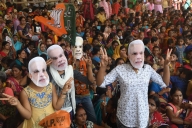New Delhi (IANS) The evolution of the BJP under PM Narendra Modi has been stark, redefining and reimagined. Even as one seeks clues to covert and overt Hindu resurgence and revivalism, one cant run away from the fact of how a party predominantly of the forward castes — a mirror image of its ideological parent RSS — has quietly gone about and acquired a brand new hue.
Undergoing a massive metamorphosis, it has made a conscious effort to transform itself from being an urban, middle class, trader party to one that has also brought in the backwards in rural India along with the poor and underprivileged into its fold. Even the party ‘s candidate selection is mirroring this change. From The Bharatiya Janata Party, it has turned into a Backward Janata Party and this migration has been more or less seamless.
When the candidate selection for the general election for Uttar Pradesh 2019 began, the new construct fell into place. Fifteen seats were allotted to Brahmins, 14 to backward community leaders, 13 to Dalits, 10 to Kshatriyas, four Jats, two Gurjars and one each to Vaishya, Parsi and Bhumihar castes. This break-up was for the original 61. A party leader added: “The BJP has applied (the) tested social engineering formula and its major thrust in this election seems to be on the non-Yadav OBCs, non-Jatav SCs and upper castes, especially Brahmins and Kshatriyas, due to Chief Minister Yogi Adityanath.
The party also dropped several sitting MPs keeping in mind local factors. Of the 13 legislators who fought these elections, as many as 11 won. Those dropped include BJP stalwart Murli Manohar Joshi (Kanpur), Priyanka Rawat (Barabanki-SC), Ashok Dohrey (Etawah-SC), Bharat Singh (Ballia), Rajesh Pandey (Kushinagar) and Nepal Singh (Rampur). The BJP also gave tickets to eight women, including Maneka Gandhi, Rita Joshi and Jaya Prada.
Imagine how wrong political wisdom and punditry was when Samajwadi Party supremo Akhilesh Yadav countered this change by saying: “The BJP will win only one seat in the state and the rest will be in our kitty. The people of the state are looking for an opportunity to rid themselves of BJP’s misrule”.
Thrice in a row now BJP has defied this same conventional wisdom and punditry by sweeping UP. The people of UP have now emphatically voted for NITA – Narendra Is The only Alternative. Each time the results have been jaw dropping – 2014, 2017 and 2019. But let us rewind to see how the seeds of this architecture were sown. Let us come to what became ultimately a seminal election, I would think, bigger and perhaps more important than the 2014 general election.
UP-2017 was a battleground like no other. As is the wont of the liberal and compromised media (a pink paper), a nauseatingly faux narrative was spread. I give you the example of an analysis based on a Post Poll (and an exit poll for the last voting phase) conducted in Uttar Pradesh by Lokniti, Centre for the Study of Developing Societies (CSDS), Delhi, for ABP News. The survey was conducted from February 14 through March 8, 2017 among 6,269 voters in 395 locations (polling stations) spread across 65 assembly constituencies. These are the same constituencies and polling stations where Lokniti had conducted the earlier rounds of the Tracker survey in July and December 2016, and January 2017.
It maintained that the Uttar Pradesh assembly election looked all set to go down to the wire. According to the CSDS-ABP News Post Poll survey, both the Samajwadi Party-Congress alliance and the Bharatiya Janata Party were locked in a very tight contest. Both the parties were likely to get around 32 per cent of the total votes. Mayawati’s Bahujan Samaj Party was expected to a finish third with a likely vote share of 25 per cent. Maybe CSDS-ABP just got it completely wrong as pollsters.
As opposed to the Muslim vote bank, the rapid rise of the Hindu vote bank, standing as one behind PM Modi is a phenomenon which is a reality that the new India has to deal with. In 2014, the young and restless � aspirational and ambitious � connected with Modi’s brand of neo realpolitik predicated as it was on development and growth and jobs. Three years later, how and why did the Hindus cutting across all caste and community identity politics once again stand behind Modi? Call it covert or overt Hindutva, it succeeded, paying the BJP and Modi a dividend in spades.
In Uttar Pradesh, the BJP won 312 seats, including some of the Muslim-dominated seats such as Deoband, Chandpur, Moradabad Nagar, Noorpur, Naanpara and Nakur where pundits reckoned that Muslim votes got divided between Muslim candidates of the Samajwadi Party and the Bahujan Samaj Party. The communal violence in Muzzafarnagar actually worked to the detriment of the ruling SP, as did the administrative lacunae owing to multiple power centres.
Against that the BJP under a tireless and indefatigable Modi succeeded in getting votes of Hindu backward castes minus Yadavs and Scheduled Castes minus Jatavs, it was a spanking new paradigm, leaving everyone wondering how a Hindu consolidation had come about. Thrice now in UP, one has been witness to this aggregation and it cannot be dismissed as an urban legend anymore. The fact that the Congress chose to walk the same path in Gujarat is telling. Imagine Manik Sarkar too succumbed to this temptation, but was vanquished. The role played by some of the women liberating schemes such as Swachh and Ujjwala this time also cannot be undermined.
The aggregate vote share of BJP and its allies was 41.4 per cent in the 2017 election, an eyelash less than the 43.6 per cent it received in 2014. Even their performance over the seven phases of the election closely mirrors their performance in 2014. They had a strike rate of 90 per cent in phase 1 (93 per cent in 2014), 75 per cent in phase 2 (73 per cent), 80 per cent in phase 3 (75 per cent), 83 per cent in phase 4 (77 per cent), 85 per cent in phase 5 (85 per cent), 67 per cent in phase 6 (88 per cent), and 80 per cent in phase 7 (100 per cent).
Curiously, the BJP and its allies only fell marginally, in comparison to their aggressive 2014 performance, in the final two phases of the election where Gorakhpur mahant Yogi Adityanath and Narendra Modi himself were expected to deliver Lucknow for their party.
Modi’s Hindutva pitch based on an edifice of Hindu Rashtrawadi aggro was much greater than the combined secular template of the opposition. With cash cull hitting Mayawati’s treasury operations, Modi played the Hindu card. In his Fatehpur speech on February 23, he delivered the kayo punch on the opposition’s glass jaw: “If you create a kabristan in a village, then a shamshaan should also be created � Bhedbhaav nahin hona chahiye (there should be no discrimination).” This worked like clockwork as it tied in perfectly with the subliminal Hindu rashtra messaging eloquently, squeamishness be damned.
According to the India Today Axis poll in the run-up to the hustings – Apart from Brahmins and Thakurs, a major section of non-Yadav OBCs were also supporting the the saffron party:
*58 per cent of Muslims were in support of Samajwadi Party, 3 per cent BJP, 14 per cent BSP.
*67 per cent Yadavs behind Samajwadi Party, 14 per cent with BSP, 6 per cent with BJP.
*59 per cent of Brahmins supporting BJP, 9 per cent with BSP, 14 per cent with Congress.
*Among OBCs, 56 per cent are supporting the BJP. 15 per cent of OBC with BSP, 13 with SP and 7 per cent with Congress.
The grand Hindu coalition can work in states where there is a Hindu-Muslim divide and the latter have a sizeable population. It did not work in Punjab, Delhi or Bihar, but it did work for both parties in Gujarat. Mamata’s Bengal is the latest experimental lab for this model to succeed. Populist development and Hindutva Plus also connected with Bihar this time round, leaving behind a rout. Conversely, it worked in Assam, in Jammu division of J&K and in Tripura state election.

